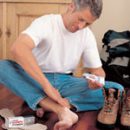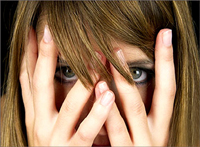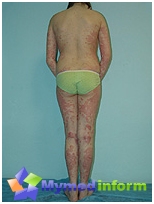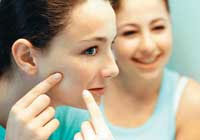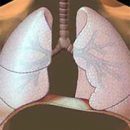Those who have encountered a fungus nail know how much time and patience require a procedure prescribed by the doctor. Most often, everything starts with the removal of the affected nail plate. Why it is necessary? What place in the treatment of Mikosa is occupied by surgery and hardware methods?
Content
- Why do you have to remove the sick nail?
- Two-stage approach to therapy of nail fungus
- Mechanical removal of nails
- Surgical nail removal method
- Hardware Nail Removal Method
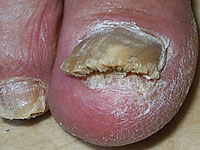 Fungal infections of nails are extremely distributed among the population, in 30–70% of cases are caused by a mushroom with a red trophyphiton, introduced into the nail from its side edges or cuticle. Most often hit nails on the legs, especially large fingers, and they, in turn, become a source of infection for the rest of the nails.
Fungal infections of nails are extremely distributed among the population, in 30–70% of cases are caused by a mushroom with a red trophyphiton, introduced into the nail from its side edges or cuticle. Most often hit nails on the legs, especially large fingers, and they, in turn, become a source of infection for the rest of the nails.
The development of fungal infection is accompanied by a gradual destruction of the nail. In some cases, it becomes yellowish-gray, thickens due to breaking and increasing the volume of nail bed tissues, then gradually peeling and begins to crumble and crack. In other cases, the nail, on the contrary, is thinned, acquires longitudinal and transverse allocations, becomes muddy and spotted due to the formation of sub-cavities filled with mushroom mycelium.
Why do you have to remove the sick nail?
Treating the fungal lesion of nails, or onychomicosis, quite complicated, requires a competent approach from a doctor and patient from the patient, so you need to recognize, often ends full fiasco. Most often, the reason for failures in the treatment of onchomicosis becomes a refusal to remove nail and hope exclusively on local or systemic therapy with antifungal drugs. However, as the experience shows, one pills and ointments of fungus are extremely difficult to defeat, and sometimes impossible. Systemic treatment costs expensive, the drugs used cause many side effects. Local treatment, such as fungal infection monotherapy, very rarely gives the necessary result due to the fact that the nail plate becomes an obstacle to the penetration of the drug to the place of inflammation.
Two-stage approach to therapy of nail fungus
Of course, systemic therapy with antifungal drugs gives a good effect, but it is not shown not to all. If less than 1/3 of the nail plate is struck, the process captured less than 3 nails, the patient refuses to receive antibiotics or they are not suitable for the presence of other diseases, local treatment is carried out.
In order to speed up recovery and increase the efficiency of local procedures, before using various creams and ointments, the nails affected by fungus are removed mechanically, with the help of keratolithic, hardware or surgical method. In particular, it is justified in the case of a pronounced subcast hyperkeratosis, when the thick layer of loose and destroyed by fungus fabrics interferes with the penetration of medication in the nail bed, where, in fact, and dwells the fungus.
It is believed that the presence of tunnels and cavities under the nailing worsens not only the results of local therapy of onychomicosis, but also reduces the effectiveness of antifungal antibiotics taken inside. In turn, the removal of sick nails makes it possible to increase the performance of therapy more than twice.
Mechanical removal of nails
This method of removal of the affected nail plate is used in patients most often. The nail is pre-sparkled and then removed with bustard and pylons.
It must be said that this method is quite effective, but applicable only if the nail defeat began with free edge or side. If the fungus led to the formation of closed cavities under the nail plate, to cope with the situation without the help of the doctor will not be able to.
Surgical nail removal method
The surgical method of removing the wrong nails affected by the fungus was previously used in medicine quite widely, it is used today, but less. Conservative removal with keratolithics requires a long time, which reduces the quality of life of patients. Operation — it is always fast and effective.
After treatment with a solution of antiseptic, overlapping a hemostatic harness on it and local anesthesia with a solution of lidocaine or ultrakina, the nail plate is separated from the nail bed with scissors and then removed with nail bearings or using a special tool. The liberated nail bed is cleaned by loose, destroyed by the fungus of fabrics, is treated with an alcoholic solution of iodine and closes with a bandage with antiseptic ointment.
More recently, the surgical removal of the nail plate was extremely painful, traumatic procedure, often resulted in damage to the spoken zone and deformation of the rustic nail. Today, the removal of nails on the old man is carried out extremely rarely, in addition, doctors use preliminary softening of the nail plate with keratolic agents, often with the plaster, superimposed on 1 day before the operation. To antifungal treatment transfers after full healing of the nail bed.
Hardware Nail Removal Method
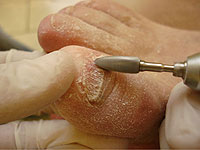 The hardware way to remove patients with nails began to be applied in dermatology relatively recently, he came to medicine from pedicure rooms and largely devoid of drawbacks of the conservative and purely surgical method.
The hardware way to remove patients with nails began to be applied in dermatology relatively recently, he came to medicine from pedicure rooms and largely devoid of drawbacks of the conservative and purely surgical method.
To remove the nails, uses devices for a pedicure with a set of different cutters, adjusting the speed of rotation of the drive shaft, equipped with instruments for collecting pathological material. The processing process of the nail plate of the mill means layer-by-layer removal of tissues, the anesthesia is not carried out, since the pain is minimal, and the preservation of sensitivity makes it possible to avoid deep injuries of the nail bed.
The cleaning of the nail bed is carried out once in 7–14 days until all the flavored fabrics are removed. Then transition to the treatment of antifungal drugs.
Pluses of the hardware removal of nails
- Treatment is carried out in an outpatient basis, it is painless, atraumatic and occupies relatively little time.
- The method can be applied in patients with diabetes mellitus, eczema, allergies for keratolytic drugs, in elderly people suffering from circulatory disorders in the limbs.
- In the process of removing the nail there is an opportunity to assemble material for further research in the laboratory and the sensitivity of the fungus to antibiotics.
- The effectiveness of treatment of the nail fungus when using the hardware method of their removal is approximately 95%.


